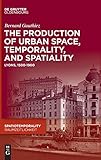The production of Urban Space, Temporality, and Spatiality : Lyons, 1500-1900 / Bernard Gauthiez.
Material type: TextSeries: SpatioTemporality / RaumZeitlichkeit : Practices-Concepts-Media / Praktiken - Konzepte - Medien ; 8Publisher: München ; Wien : De Gruyter Oldenbourg, [2020]Copyright date: ©2020Description: 1 online resource (XI, 257 p.)Content type:
TextSeries: SpatioTemporality / RaumZeitlichkeit : Practices-Concepts-Media / Praktiken - Konzepte - Medien ; 8Publisher: München ; Wien : De Gruyter Oldenbourg, [2020]Copyright date: ©2020Description: 1 online resource (XI, 257 p.)Content type: - 9783110619638
- 9783110619720
- 9783110623062
- 307.76
- online - DeGruyter
- Issued also in print.
| Item type | Current library | Call number | URL | Status | Notes | Barcode | |
|---|---|---|---|---|---|---|---|
 eBook
eBook
|
Biblioteca "Angelicum" Pont. Univ. S.Tommaso d'Aquino Nuvola online | online - DeGruyter (Browse shelf(Opens below)) | Online access | Not for loan (Accesso limitato) | Accesso per gli utenti autorizzati / Access for authorized users | (dgr)9783110623062 |
Frontmatter -- Foreword -- Contents -- Introduction -- Part One: Spatializing and historicizing materiality -- Part Two: Demography and building typology -- Part Three: Temporalities of urban fabric production -- Conclusion and discussion -- Appendix: 27 images from the film of building activity at Lyons from 1620 to 1830, one image per 10 years -- Abstract -- List of Figures, Graphs and Tables -- References -- Index of persons and places -- Subject index
restricted access online access with authorization star
http://purl.org/coar/access_right/c_16ec
The production of urban space in scarcely studied by scholars in historical and urban studies, the city being still predominantly seen as a frame in which activities and social relationship develop, not a produce in itself. The scope of the book is the comprehension of this production. This implies an adequate conceptualisation of the way urban space can be measured and broken down in units which can be put in relation with social processes and agents. A first part examines the concepts and their implications. The second part deals with the anthropology and typology of architectural production considered in relation to demography. The third part develops on the rhythms of the space production at Lyon from the late 15th century to the 19th. The temporalities and spatialities of the production are determined and examined. The agents of the production are studied all along the period, in parallel to the market aimed at: investors in real estate, tenants, activities. Each phenomenon identified can be described and understood as in the meantime a temporal, spatial and social unit.
Issued also in print.
Mode of access: Internet via World Wide Web.
In English.
Description based on online resource; title from PDF title page (publisher's Web site, viewed 28. Feb 2023)


